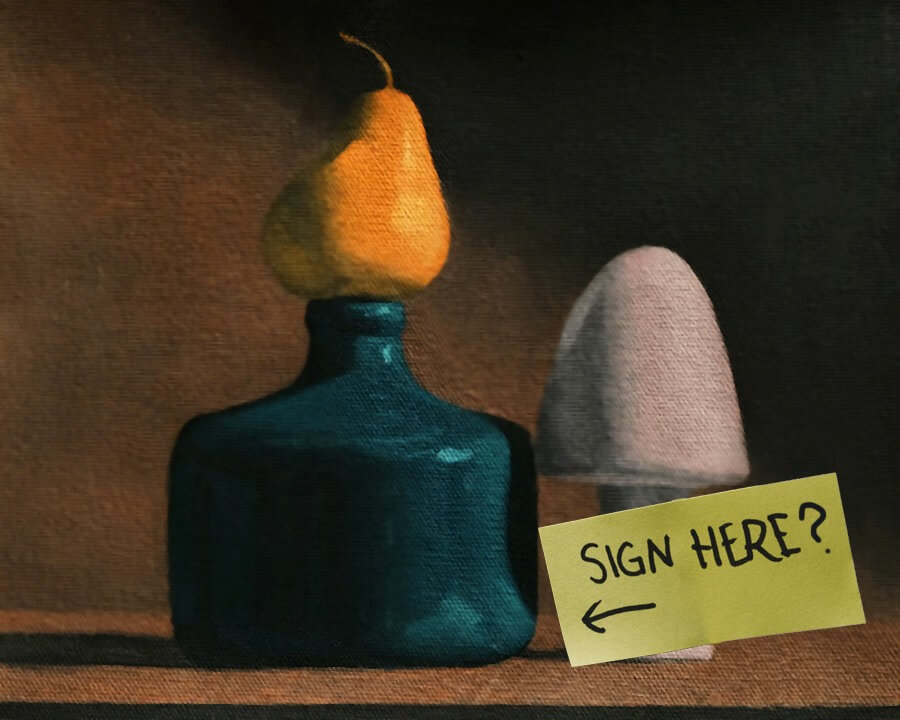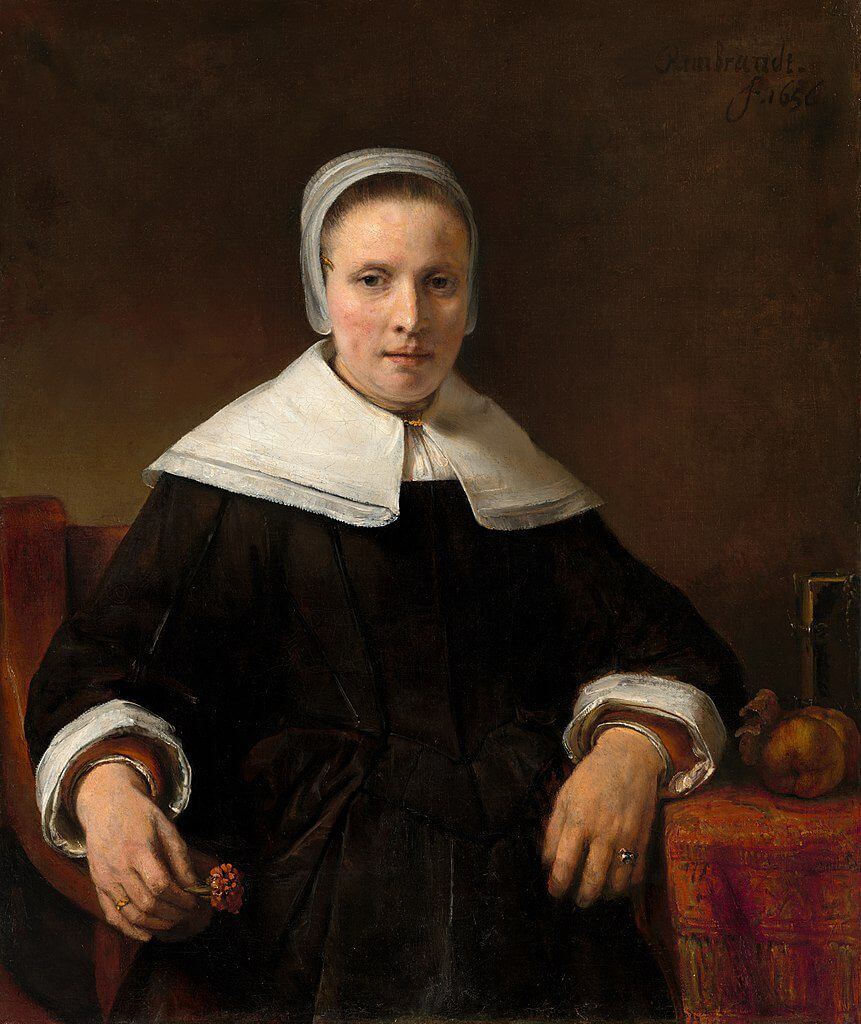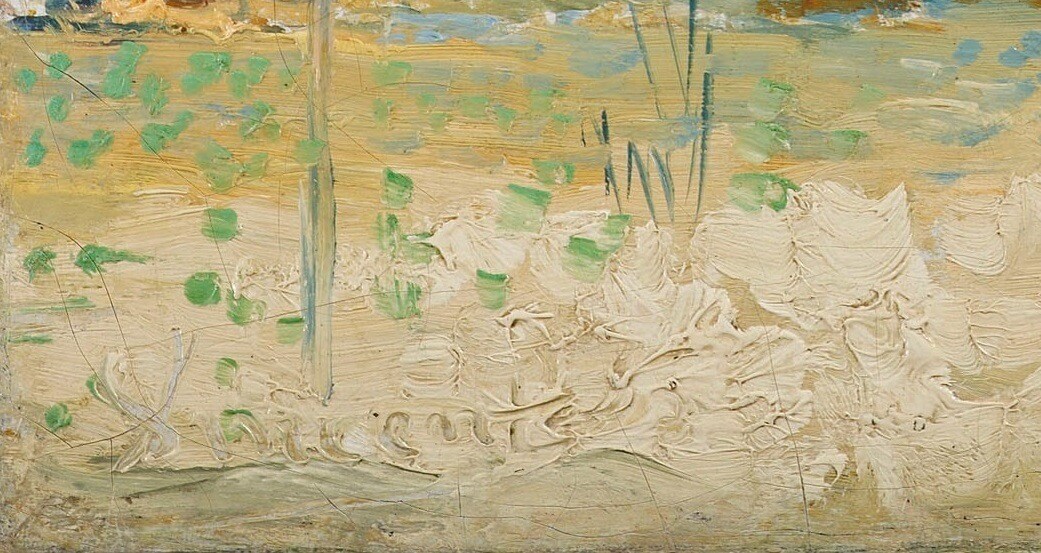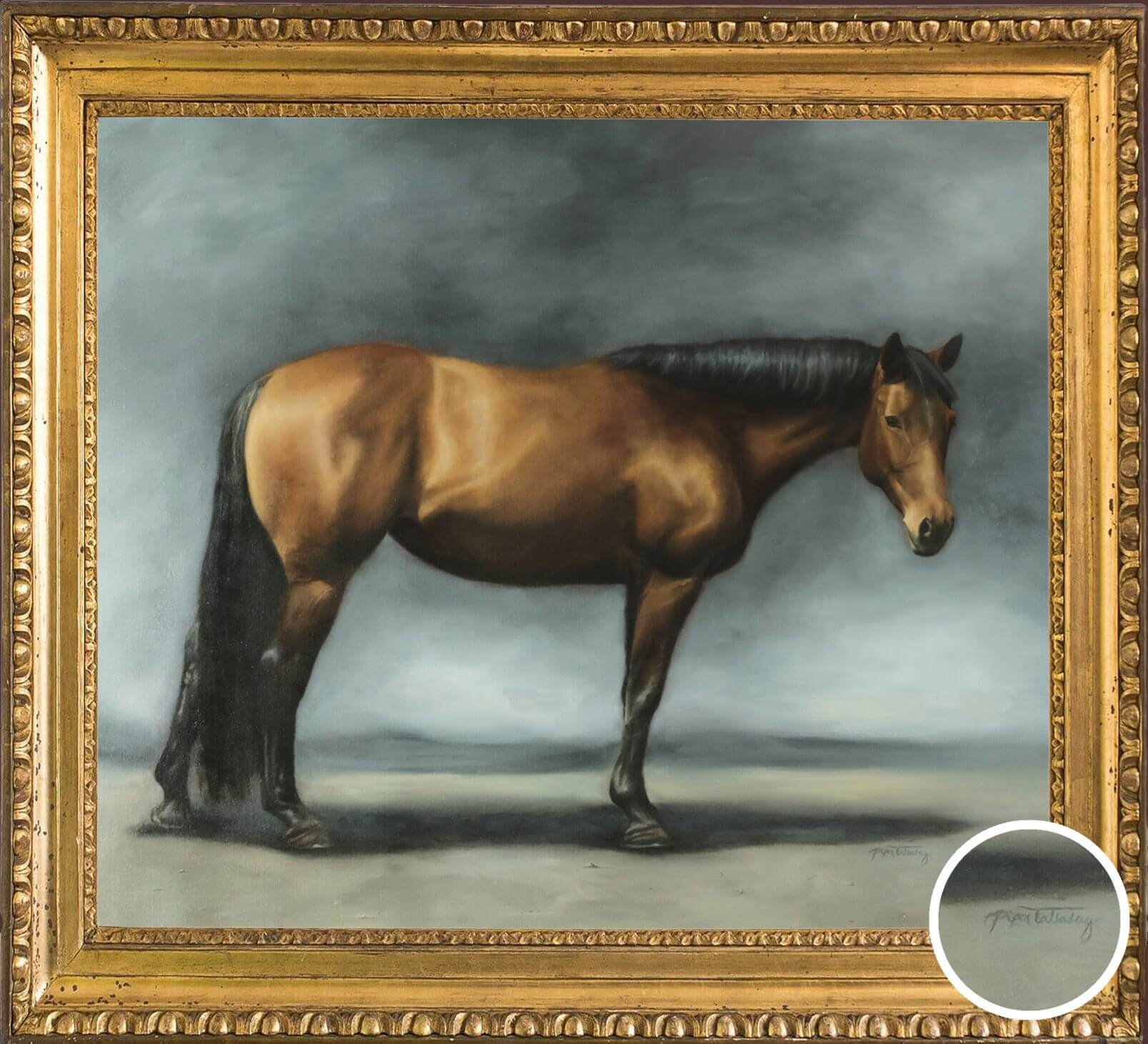
An artist signature should be an extension of the artist. Here, Richard Ensing signs his painting boldly.
More...
An artist's signature is a calling card. Signing a painting claims ownership, gives additional value, and marks it as a complete, sellable piece.
However many artists struggle with signing their paintings. Figuring out what your signature is an important part of establishing yourself as an artist.
I'm Piper Talladay, Head Instructor at Evolve Artist. In this post, I will breakdown what you need to know to create your own artist signature.
Let's first start by asking - what makes a good artist signature?
What Makes a Good Artist Signature?
A not-so-great artist signature feels jarring to a painting.
A good artist signature is meant to be a part of your painting. It should effortlessly complement the rest of the painting without drawing undue attention to itself. It is like the punctuation at the end of a thoughtful personal monologue - not the monologue itself.
Your signature should also feel like your work. It is your own and unique.
Creating your artist signature will take some thought and practice. But don't worry. We'll take you through the key aspects to consider through when creating your signature.

“Artichokes on a Crate” by Brent Erickson, signed with the artist’s initials in a trompe l’oeil style, fitting in with the rest of the painting. (Courtesy of The Art League)
What to Sign for Your Artist Signature
An artist signature must communicate the identity of the artist.
Your artist signature needs to be:
- Clear - it must be clear who has painted the piece.
- Consistent - it must be the consistent across your work.
You might feel like an obscure unclear signature is creative, but its important for your artist signature to be clearly yours.
Here's why:
- A signature is a business card. If you choose to sell your work, it tells people who created the painting. With that information, they can find your website or information to contact you.
- A signature makes it clear what work is yours. Changing the artist signature on your paintings will make it difficult to identify your work.
A clear and consistent signature format that many artists use is their first name and last name, in variations, either in full or initials.
For example, I sign my full name on my work, but I could also sign P.Talladay, Talladay, P.T., etc.
Once you’ve discovered what to sign, the next question is when should you sign it?

Rembrandt’s painting, “A woman Holding a Pink” (1656) shows his signature, signed in similar colors to the rest of the painting. (The National Gallery of Art)
Should I Sign When My Painting is Finished?
You might assume that an artist signature is always done at the end when a painting is complete. Signing at the end is a tried and true practice - but may have a slightly less integrated feel to it.
If you remember, an artist signature shouldn't be an afterthought. It is an integrated piece of the painting.
Given this, you can sign as you work, and consider how you might include your signature as an element of your painting. Many artists choose to do this. This allows the signature to become a part of the painting.
Where Should I Sign My Artist Signature?
When choosing a place for an artist's signature, it is important to consider composition and your personal style.
The signature is a part of the painting, so it must be balanced and in line with the rest of the piece. Your signature is also meant to be a part of your painting, so consider your style as you sign.
Here are our top suggestions:
- Consider using the signature to balance out a compositionally uneven area in the painting.
- Cleverly hide or integrate your artist signature within the painting, to look as though it were etched into bronze or carved into wood features.
- Make your artist signature style consistent with the style of your artwork. If you produce elegant work, have an elegant signature that feels as though it comes from the same hand.
As an artist, your work should be an extension of who you are, and your signature is a part of that work. Considering composition, style, and placement will help to explain who you are to your viewers.

Vincent Van Gogh’s signature is etched into the wet paint with the backside of the brush.
What Brush and Color Should I Use for My Artist Signature?
Many artists choose to sign their paintings with a small, round or flat brush.
Add medium, so the paint flows freely, and the brushes are somewhat similar to a pen, depending on the substrate you choose to paint upon.
Practicing to see how the paint reacts to your signature is a good idea. Taking the time to practice, but try not to obsess. This will help keep your artist signature thoughtful, but natural.
The color of the signature depends on the painting. If you want the signature to stand out, perhaps you will choose a bold color in a red or a blue.
But if the signature is meant to quietly compliment, you should choose a color that complements the overall colors of the painting.
If you are working with thick paint in puddling or an impasto technique, you may choose a different route for your signature.
You may wait until the entire painting is dry. Or you may follow in the footsteps of artists like Vincent Van Gogh and scratch your signature into the wet paint with the wood end of the brush.

Evolve Head Instructor Piper Talladay’s signature is done in a small script, often placed in the foreground of the painting.
Making your Artist Signature Your Own
As you develop your artist's signature, remember that your signature and your work is an extension of who you are.
So when you're trying to figure out what your signature should look like, take a look at your work. Is it harsh or jagged? Delicate or bold? Does it shout or is it a whisper?
Your signature should fall in line with your personality, and your personality should be seen in your work. The best way to find your artist's signature is to study your own work.
Want to improve your painting skills and techniques? Read more here:
FREE MASTERCLASS:
The 4 Part Framework to Develop Artistic Excellence in 12 Months
FAQs - How to Create an Artist Signature
Glazing techniques are used to create a variety of effects. The most common ones include: glazes, washes, and stains. They can all be applied at any time during the painting process.
Glazing is a technique used to create the illusion of depth and dimensionality. It’s also known as “painting on glass,” but that doesn’t really do it justice because glaze isn’t just painted over the top of the canvas. Glaze is applied to the entire canvas, creating a translucent effect. When properly done, the glaze creates a three-dimensional look that makes the viewer feel like he or she is looking at something real.
Glazing is another tool that you can use to expand the possibilities for your artwork. Glazing is not necessary to create a realistic painting, but when it comes to if you should or shouldn't do it, first make sure you know what you are doing and then use the technique to enhance your work.
Glazing techniques are used to create a variety of effects. The most common ones include: glazes, washes, and stains. They can all be applied at any time during the painting process.
Glazing techniques are used to create a variety of effects. The most common ones include: glazes, washes, and stains. They can all be applied at any time during the painting process.
Glazing techniques are used to create a variety of effects. The most common ones include: glazes, washes, and stains. They can all be applied at any time during the painting process.
Glazing techniques are used to create a variety of effects. The most common ones include: glazes, washes, and stains. They can all be applied at any time during the painting process.
